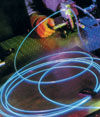

Researchers in the UK announced a major breakthrough in laser technology with the development of a fibre laser having a continuous output power of more than 1 kW in a high-quality beam. It claims to be the most powerful single-fibre laser in the world, and that it will revolutionise aerospace, automotive and other industrial manufacturing applications.
Professor David Payne, director of the University of Southampton's Optoelectronics Research Centre (ORC), commented, "Breaking the 1 kW barrier with a single fibre and achieving high beam quality is a milestone thought to be unattainable just a few years ago, and now we have done it. Our high-power fibre laser programme team has set many world records over the past two years, but this one stands apart."
Compared with conventional industrial lasers, fibre lasers are flexible, compact and robust solid-state sources that have intrinsically high beam quality. Applications are in welding, cutting and marking of metals and ceramics. For example, a number of car manufacturers now use laser welding to assemble vehicle bodies.
Rapid advances are being made in the development of fibre lasers in the UK leading to fibre laser specifications that either closely match or more generally exceed those of traditional lasers. The primary advantages of fibre lasers are their superior beam quality, greatly reduced footprint and the lack of need for maintenance - radically reducing the user's total cost of ownership and increasing productivity (in some cases by as much as 25%).
Enabling this transition are a number of patented innovations originating from the ORC, including increased pulsed capabilities, improved laser diode to fibre coupling and advances in specialty fibre for the active medium. Fibre lasers and amplifiers were first developed here in the mid-1980s and soon revolutionised telecommunications by allowing low-noise, all-optical amplification of data-carrying optical signals.
Today's fibre lasers operate on similar principles to these telecommunication amplifiers but the fibre designs and sources used to power them have been adapted to allow operation at kilowatt power levels rather than the small fraction required for communications. To make such a laser, the tiny fibre core is doped with lasing ions identical to those used in large industrial lasers. Remarkably, the ORC has found that the faint glow that powers the Internet can be scaled to a kilowatt level - sufficient to slice steel plate.
Southampton Photonics (SPI) is working closely with the ORC to licence this technology and expand its scope. SPI now develops and manufactures state-of-the-art continuous wave and modulated fibre lasers, components and subsystems, with powers ranging from a few watts to several kilowatts for a variety of industrial applications.
For more information contact the Optoelectronics Research Centre (ORC), University of Southampton, [email protected], www.orc.soton.ac.uk

© Technews Publishing (Pty) Ltd | All Rights Reserved